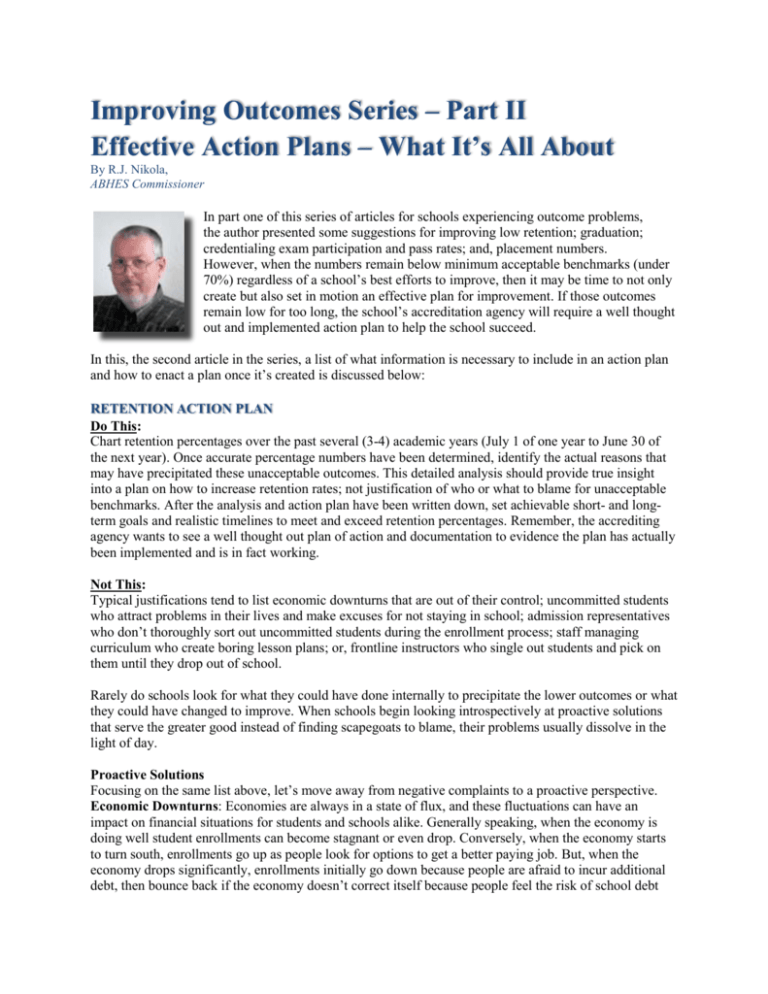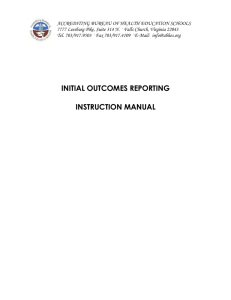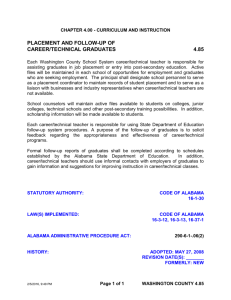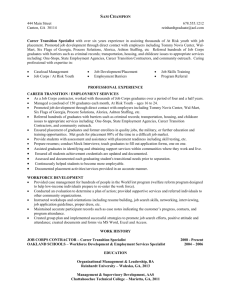Effective Action Plans
advertisement

Improving Outcomes Series – Part II Effective Action Plans – What It’s All About By R.J. Nikola, ABHES Commissioner out In part one of this series of articles for schools experiencing outcome problems, the author presented some suggestions for improving low retention; graduation; credentialing exam participation and pass rates; and, placement numbers. However, when the numbers remain below minimum acceptable benchmarks (under 70%) regardless of a school’s best efforts to improve, then it may be time to not only create but also set in motion an effective plan for improvement. If those outcomes remain low for too long, the school’s accreditation agency will require a well thought out and implemented action plan to help the school succeed. In this, the second article in the series, a list of what information is necessary to include in an action plan and how to enact a plan once it’s created is discussed below: RETENTION ACTION PLAN Do This: Chart retention percentages over the past several (3-4) academic years (July 1 of one year to June 30 of the next year). Once accurate percentage numbers have been determined, identify the actual reasons that may have precipitated these unacceptable outcomes. This detailed analysis should provide true insight into a plan on how to increase retention rates; not justification of who or what to blame for unacceptable benchmarks. After the analysis and action plan have been written down, set achievable short- and longterm goals and realistic timelines to meet and exceed retention percentages. Remember, the accrediting agency wants to see a well thought out plan of action and documentation to evidence the plan has actually been implemented and is in fact working. Not This: Typical justifications tend to list economic downturns that are out of their control; uncommitted students who attract problems in their lives and make excuses for not staying in school; admission representatives who don’t thoroughly sort out uncommitted students during the enrollment process; staff managing curriculum who create boring lesson plans; or, frontline instructors who single out students and pick on them until they drop out of school. Rarely do schools look for what they could have done internally to precipitate the lower outcomes or what they could have changed to improve. When schools begin looking introspectively at proactive solutions that serve the greater good instead of finding scapegoats to blame, their problems usually dissolve in the light of day. Proactive Solutions Focusing on the same list above, let’s move away from negative complaints to a proactive perspective. Economic Downturns: Economies are always in a state of flux, and these fluctuations can have an impact on financial situations for students and schools alike. Generally speaking, when the economy is doing well student enrollments can become stagnant or even drop. Conversely, when the economy starts to turn south, enrollments go up as people look for options to get a better paying job. But, when the economy drops significantly, enrollments initially go down because people are afraid to incur additional debt, then bounce back if the economy doesn’t correct itself because people feel the risk of school debt outweighs the fear they may get further behind in debt. Their hope is to get a better paying job in a career that is forecasted to grow over the normal life of their student loan(s). Schools must help students remain calm and committed once in school. They can do this by first only enrolling people who are not in financial straights to begin with, have dependable transportation, and already have a support system in place to help them through school. Second, administrators can visit with students individually once a month to see how school, work and family are doing. Providing low- or nocost tutoring or space for study groups for struggling students; finding low cost day care; and, posting carpooling opportunities can go a long way in helping students achieve their goals and graduate on time. Obviously we are not social workers, family counselors or legal mediators, but providing access to those types of resource lists ahead of time may prevent a student from withdrawing from school. Uncommitted Students: Chances are no matter how well admissions and financial aid staff screen prospective students, some just lack the motivation or ability to come to school on time or study for tests. By visiting students as described in the previous paragraph and taking steps to provide them the tools to solve their own problems, chances are that drop rates for uncommitted students will go down as well. The proactive approach is not to sit back and wait for monthly reports that identify, after the fact, that someone dropped out of school. The time to act is before the student even thinks of dropping out as an option. Poor Admission Representatives: Again, the proactive stance is to thoroughly train admission reps. instead of firing them and hiring new people. Admissions reps. tend to be sales-oriented (enrollments being the product) and not student-oriented (helping the student choose are career that fits them best). We have all heard instances where admission reps push a prospect into an expensive program where none is needed or where few jobs are available once they graduate. Let us not be driven by double-digit bottom lines, and start helping people to find an education that they can handle during school and successfully pay off once out of school. Be careful to make certain the staff understands the school’s mission can serve everyone involved in good and poor economic conditions alike. Poorly Constructed Curriculum: It is productive to rethink program curriculum from time to time to see if subjects are current and interesting and better assist students as professional scope and student populations morph over time. Also, if instructors are still using overhead transparencies, maybe it is time to convert to Power Point presentations that are colorful, graphic, hold student interest in the classroom, and are both fun as well as educational. Again, being proactive means staying on top of student and industry needs; not waiting too long then firing staff and faculty because of administrative procrastination or lack of insight. Staff should be encouraged to make an analysis and offer suggestions to change course work, periodically; but, keep in mind that they may fear making a poor suggestion or being thought of complaining about the curriculum that has been effectively working for so long. Retention is all about relationships – provide all the interest and concern of a caring parent. CREDENTIALING/LICENSURE ACTION PLAN Do This: Similar to the Retention Action Plan, the institution should first chart credentialing participation rates, exam pass rates, and licensure rates over the past several (3-4) academic years (July 1 of one year to June 30 of the next year). Once accurate numbers have been determined, identify actual reasons that may have precipitated unacceptable numbers. This detailed analysis should give true insight into a plan on how to increase credentialing participation, exam pass rates and licensure rates, not justify who or what to blame for unacceptable benchmarks. After the analysis and action plan have been written, set achievable shortand long-term goals along with realistic timelines to exceed past and current percentages. Lastly, remember the accrediting agency will want to see documentation evidencing that a well thought out plan of action has been implemented and works. Not This: Don’t play the blame game. Schools sometimes complain that credentialing is not necessary for employment. And, while that may be true in some states throughout the country, it is generally not the case all over the United States. Also, graduates may eventually move out of state. Take the proactive approach to prepare students not to just take their credentialing exams, prepare them to pass those exams. Schools can do this by adding courses on preparing to successfully take their credentialing exams and offering to pay for online unlimited practice exams within a 30-day timeframe. It’s a small investment with a huge potential for reward that goes a long way to helping graduates pass their exams as well as demonstrating the school is student friendly. Having faculty rewrite their class exams to more closely resemble the credentialing exam also gets students comfortable with those types of questions that make one think, not just memorize. Some schools complain graduates do not sit for the credentialing exam because it is too expensive. A proactive approach would be to pay for the exam and roll exam fees into the overall cost of attendance. Look for what could have been done to precipitate the lower outcomes and what could be done now to improve. When schools begin to look for solutions rather than staying focused myopically on problem(s), everything begins to fall into place. Credentialing/Licensing is all about instilling faith – faith the graduate can do it. Demonstrate faith and confidence graduates can succeed in life, and they probably will. PLACEMENT ACTION PLAN Do This: The big difference between a Placement Action Plan and other action plans is that a school will need to justify maintaining a program with recurrent low placement rates, which must include a detailed market survey (details outlined below). A chart will still be needed to show several years (3-4) of placement percentages of what the trend has been and where it is currently. Additionally, provide a list of accurate reasons for why the rates have been and are still below acceptable benchmark standards, as well as what the school’s plan is to increase those rates both in the short- and long-term, along with a timeline for achievable placement goals. Demonstrate that the plan has been implemented by submitting evidence to the accrediting agency. Not This: Do not blame others or focus on negative aspects. Look for solutions by pooling staff for possible problem-solving measures. They can be a marvelous resource of information in developing and implementing an effective action plan. Problems usually listed as contributing factors to low placement rate include: economic downturns, few job opportunities or hiring freezes in the field, too many people signing up for the program, poor performance of career services staff or department heads, unprofessionalism among graduates, etc. Just remember to focus on proactive solutions. Detailed Market Survey Schools generally need to write a detailed market survey or analysis when applying to their accrediting agency to add a new program, new campus, or when submitting a placement action plan when outcomes stay low for too long or are far lower than acceptable benchmarks. A market analysis needs to contain at a minimum the following elements: 1) a thorough survey of potential employers that demonstrates expected qualifications required of graduates entering the field, 2) proof of sufficient signed externship sites to handle expected program enrollments, 3) an established advisory board that is in place to review and that has given feedback on the school’s analysis prior to being submitted to the accrediting agency, 4) projected salaries graduates might realistically expect from various employment sectors in various population areas to show the relationship between planned cost of attendance and graduate success, 5) a list of competing institutions comparing programs offered, student populations & demographics, training facilities and disclosed outcome rates, and most importantly 6) a summary of how the collected information evidences a compelling need to add a new campus or program, or to continue the existing program in cases of an action plan. As local, regional, or even national economies experience extended downtowns, chances are there will be fewer employment opportunities and possibly even hiring freezes in certain sectors. It is important to emphasize that it is the school’s responsibility to anticipate economic trends, enroll only as many students as their staff can realistically place, AND no more than the market can bear regardless of what the U.S. Bureau of Labor and Statistics may predict. If the number of graduates can be anticipated prior to the last day of classes (month-by-month basis), then the school can successfully plan the number of jobs needed to place their graduates. If there are credentialing needs for licensure/employment, then that estimated timeline should be part of the equation, thus the equation should look something like this: anticipated # of grads by _____ date + # of months to apply/study/take exam, means # of jobs needed by ______ date. Placement is all about service – going the extra mile in hunting down active jobs and connecting graduates with employers. Conclusion Do This: Analyze-Identify-Fix-Prove! Not This: Ignore-Deny-Justify-Blame! Remember to stay focused on proactive solutions rather than blaming others for any lack of insight on the school’s part because it is all about RELATIONSHIPS, FAITH, and SERVICE: 1. Show a genuine interest and concern for the students’ welfare; 2. Demonstrate and instill faith and confidence in their ability to succeed; and, 3. Go the extra mile to find active jobs and then connect those graduates with employers to “seal the deal.” Mr. Nikola has been a massage therapist, educator and author for more than 20 years. He owns Healing Mountain Massage School with two campuses in Utah. He currently serves as a commissioner (member of the Board of Trustees and Executive Committee) in a volunteer capacity for the Accrediting Bureau of Health Education Schools (ABHES).






